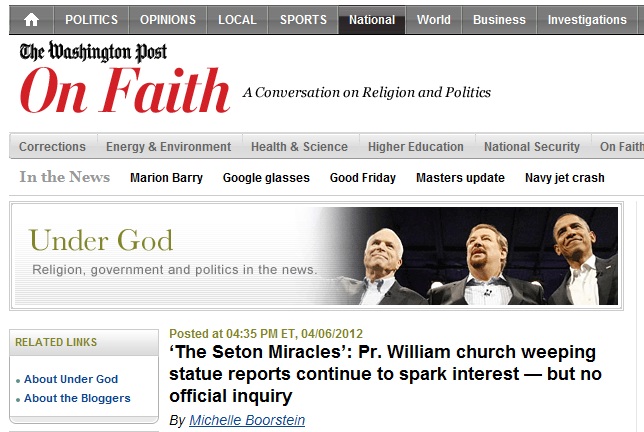‘The Seton Miracles’ Pr. William church weeping statue reports continue to spark interest — but no official inquiry. |

April 6, 2012 - Reported in [TheWashington Post] by Michelle Boorstein - Who knew the subject of miracles was so sensitive?
Some of you may remember [the flood of publicity] that came to a Roman Catholic parish in Prince William County, Va., in the early 1990s after hundreds of people witnessed what appeared to them to be multiple statues weeping in the presence of one of the parish’s priests. The statues were mostly of the Virgin Mary. People said crucifixes and pictures wept, too, some profusely.
Yet even as media and buses of pilgrims descended upon St. Elizabeth Ann Seton Church, leaders of the Arlington Diocese played it down, issuing a statement in early 1992 saying they had concluded “there is no determined message attached to the reported physical phenomena, and thus there is no ecclesial declaration to be made at this time.”
Local Catholics took that as a sign to back off and eventually, over the years, the case faded. But not for everyone.A small group in Northern Virginia and around the country has held fast to what they call The Seton Miracles and some have recently been pushing the diocese [to open an investigation]. More than 130 people have signed a petition for a deeper probe and a Woodbridge non-profit continues to sell a memoir of the weeping-statue years written by a lawyer-parishioner at the church at the time named James Carney.
And they seem-- seem-- to have a powerful advocate on their side. Supreme Court Justice Antonin Scalia, who often speaks to crowds about spiritual and religious themes, has in the last year or so given several lectures urging Christians to embrace the supernatural, the unbelievable, the miraculous — and to reject what he calls a scornful, skeptical secular elite. In a 2012 speech in Annapolis, Scalia cited the Seton Miracles and said this: “What is irrational is to reject a priori, with no investigation, the possibility of miracles in general and of Jesus Christ’s resurrection in particular – which is, of course, precisely what the worldly wise do,” according to Catholic media that covered the talk to the St. Thomas More Society of Maryland.
[Scalia appeared to mention the case again] last month at a talk to a Catholic group in Denver, saying: “In Washington ... the pundits and media couldn’t believe in a miracle performed under their noses,” The Denver Post reported. Scalia’s office said he wouldn’t comment or clarify how he feels about the diocese’s decision not to investigate the case. Scalia is a pious and conservative Catholic who has been critical in the past of Catholics who challenge official church teaching. The issue highlights the sticky business of miracle confirmation in an era when something may not be believed if no one tweeted it.
Yet a Green Bay, Wis., bishop recently became the first high Catholic official [to approve a sighting of the Virgin Mary in the United States]— albeit 150 years after the fact. And Bishop David Ricken is no outlier; [he was last year named head of the church’s efforts on evangelization] in the United States.
A spokeswoman with the Arlington Diocese told me there is no plan to open an investigation, as the claim of a miracle didn’t “meet the criteria of a public revelation or an apparition.” Which is? The criteria, Caitlin Bootsma wrote in an e-mail, is not about whether a physical phenomena happened, but about what its meaning or message might have been. No message, no miracle, in other words.
“The criteria is based on whether reported miraculous occurrences have a universal message attached to them or not. Apparitions and public revelations both include messages applicable to the wider Church and therefore can lead to further investigation. For example, the Church investigated and recognized as a miracle the appearance of Mary in Fatima, Portugal. In those instances that Mary appeared in Fatima, she encouraged the world to pray for peace. The Church recognized this as a verifiable miracle including a fruitful message for the whole world,” she wrote.
The Rev. Thomas Weinandy, executive director of the U.S. bishops’ conference committee on doctrine, also said miracles aren’t validated based on their wow-factor, but on what they say. “If someone says they had a vision of Mary, and she said ‘Abortion is fine,’ then you know dang well it didn’t happen,” Weinandy said. Another factor in weighing an alleged miracle’s truth, he said, is how long regular Catholics stay interested in it. But doesn’t the diocese’s lack of attention to the Lake Ridge case play a role in why most Catholics lost interest in it?
“For Christianity, the incarnation, the resurrection, weeping statutes are pretty low down on the totem pole. So you got a statute weeping, what does it mean?”
